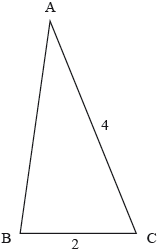| Date | November 2018 | Marks available | 6 | Reference code | 18N.1.SL.TZ0.S_5 |
| Level | Standard Level | Paper | Paper 1 (without calculator) | Time zone | Time zone 0 |
| Command term | Find | Question number | S_5 | Adapted from | N/A |
Question
Consider the vectors a = and b = .
Find the possible values of p for which a and b are parallel.
Markscheme
* This question is from an exam for a previous syllabus, and may contain minor differences in marking or structure.
METHOD 1 (eliminating k)
recognizing parallel vectors are multiples of each other (M1)
eg a = kb, = k, , 3k = p + 1 and 2kp = 8
correct working (must be quadratic) (A1)
eg 2p2 + 2p = 24, p2 + p – 12,
valid attempt to solve their quadratic equation (M1)
eg factorizing, formula, completing the square
evidence of correct working (A1)
eg (p + 4)(p – 3),
p = –4, p = 3 A1A1 N4
METHOD 2 (solving for k)
recognizing parallel vectors are multiples of each other (M1)
eg a = kb, = k, 3k = p + 1 and 2kp = 8
correct working (must be quadratic) (A1)
eg 3k2 – k = 4, 3k2 – k – 4, 4k2 = 3 – k
one correct value for k (A1)
eg k = –1, k = , k =
substituting their value(s) of k (M1)
eg , and ,
p = –4, p = 3 A1A1 N4
METHOD 3 (working with angles and cosine formula)
recognizing angle between parallel vectors is 0 and/or 180° M1
eg cos θ = ±1,
correct substitution of scalar product and magnitudes into equation (A1)
eg ,
correct working (must include both ± ) (A1)
eg ,
correct quartic equation (A1)
eg , , ,
p = –4, p = 3 A2 N4
[6 marks]


